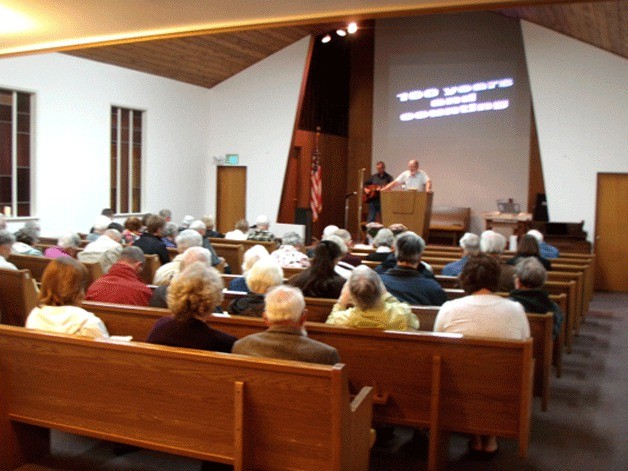Maxwelton’s Little Brown Church is easing back into business, but it remains a church in search of a flock.
“We are still waiting on the Lord to bring a congregation or two to gather here regularly for worship,” said George Mills, whose family was instrumental in the establishment of the 100-year-old landmark.
“We’ve had some inquiries, but there’s nothing definite yet,” he said this week.
Mills and his wife Lila bought the church building and parsonage about two years ago, and jumped into renovation — and into an exploration of the history of the valley.
This past May they rededicated the church, complete with a new coat of brown paint, as a non-denominational venue to be used by island residents. The church is at the intersection of Maxwelton and French roads.
Once more, the church is available for activities such as worship services, weddings, funerals, Bible studies, songfests, family reunions and community meetings.
This past Sunday, the church hosted its first wedding under the Millses’ ownership.
“Things are going pretty well,” George Mills said. “We’re waiting to see how busy we’re going to get.”
He said a Christ the King group uses the church’s fellowship hall on Sunday nights, about 40 teenagers have their Young Life meetings on Monday nights, the Millses conduct a Bible study Wednesday nights and a women’s craft group comes in on Friday mornings.
In keeping with the season, the Millses plan a Christmas carol singalong next Wednesday, Dec. 22 at the church. A potluck begins at 6, with singing at 7 p.m.
“We hope people will come,” George Mills said.
The A-frame-style church is an integral part of Mills family history.
The congregation and the church were established as Whidbey Island Free Methodist Church in the early 1900s.
The church members were called Free Methodists because, among other things, they believed it was improper to charge for better seats in pews closer to the pulpit.
George Mills’ grandparents, George and Sarah Grubb, were among the five members of the new congregation’s first official board.
In 1910, more than 80 people contributed a total of $884, and the original church and parsonage were built.
The Millses bought the church and parsonage next door in 2008. They moved into the parsonage, and began to renovate both buildings.
The church had undergone various alterations through the years, and was painted gray in 1993. It was last used as a church in 2006, and was put up for sale in 2007.
The building contains a fellowship hall in the basement, and 18 pews in the sanctuary, which was part of the original church.
The bell, still in place, was purchased in 1934 for $10 from a local school district and attached to the church roof.
George Mills said he may try to get the church classified as a historic building.
Before retiring, George Mills taught high school for 31 years in southwestern Washington. A renewed interest in his family genealogy led to the purchase and his new life on the island.
Among other things, his research discovered that legendary pro baseball player turned evangelist Billy Sunday once spoke to a crowd of 5,000 at a Chautauqua meeting at Maxwelton in the early 1900s, and that he ate dinner at George’s great-grandparents house.
“How cool is that?” Lila Mills wrote in the couple’s Christmas letter.
For information about the church, call 579-2007 or e-mail gwmills@comcast.net.



